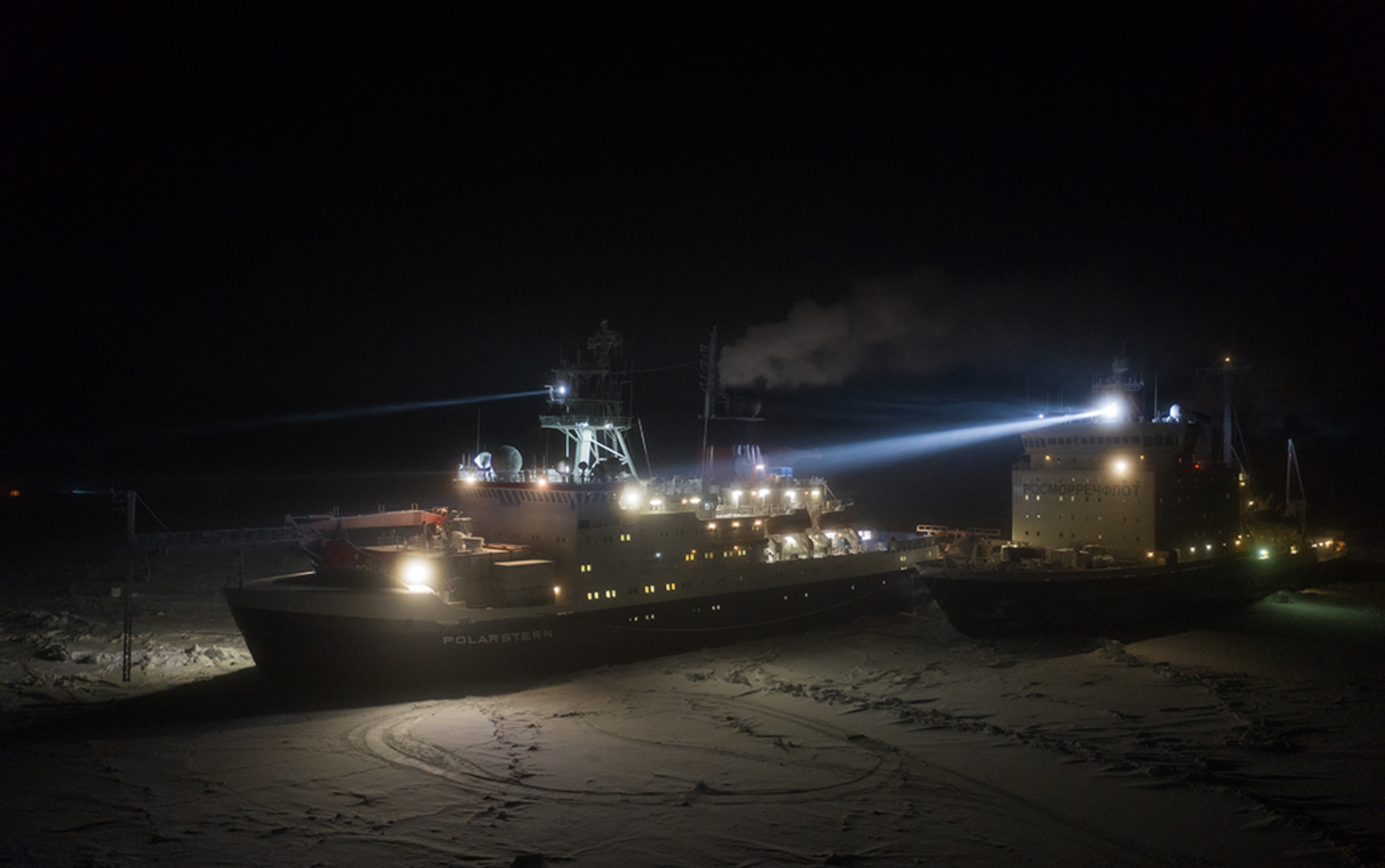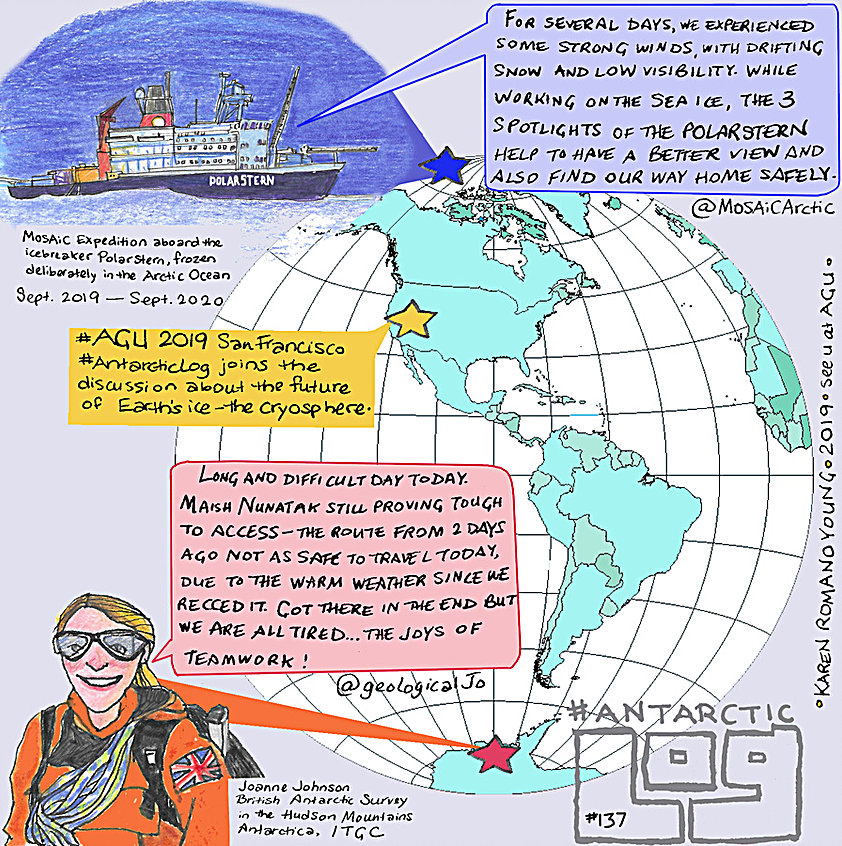Season's Greetings from the Polar Regions!
MOSAiC scientists and crew currently on the Polarstern will spend the holidays away from their friends and family in the dark and frozen Arctic. But things could be much worse for them...
In December of 1895, Fridtjof Nansen and Hjalmar Johansen of the famed Fram expedition (1893-1896), found themselves on the northern tip of Franz Josef Land waiting out the cold, harsh Arctic winter after a failed attempt to reach the North Pole on foot. In his diary, Nansen writes:
"Now the bells of home are ringing the feast of Christmas in...This is the time of rejoicing, and there is feasting in every cottage at home... But we are celebrating in our modest way. Johansen has turned his shirt inside out, and is also wearing his outer shirt underneath. I have done the same; but I have also changed my underpants and put on the others which I had wrung out in warm water. I have also had a complete wash down in a quarter of a cup of warm water using my discarded underpants as sponge and towel. I now feel like a completely new man - my clothes do not stick to my body as much as they did."
 Can you spot it?
Can you spot it?
There is something in the video above that MOSAiC participants aboard the Polarstern will never see. Can you find it?
 #askmosaic: A long long way from home
#askmosaic: A long long way from home
Submitted question: How do you feel being so far from home?
“Being from Australia, I’m a very very long way from home, here near the North Pole, and I’ll be away from home for 6 months. It’s very difficult because we can’t see the people we love, no matter how bad our day has been or how upset they are feeling. We can’t celebrate the special times or be there to help them through the tragedies. We are living in what feels like a totally different reality here, a little bubble defined by work and coworkers, which makes it easier in some ways. However, back home our families are living their normal lives, but acutely feeling our absence, a void, in everything they do.”
-Steele Griffiths, DOE-ARM, MOSAiC Team Atmosphere
Send MOSAiC participants holiday cheer by submitting your questions!
Ships Passing in the Polar Night
MOSAiC Leg II Begins
The Russian support icebreaker Kapitan Dranitsyn arrived at the Polarstern last week. Over the course of 5 days, ~100 people and supplies were traded between the two ships. A new batch of MOSAiC participants will begin Leg II of the expedition having never actually seen the ice floe they are frozen in in any kind of daylight. Photo credit: Esther Horvath/AWI
MOSAiC Leg I in Numbers
As Leg I ends and Leg II begins, MOSAiC participants from the Alfred Wegener Institute share some highlights from the first leg:
There have been polar bear sightings on 9 days, including sightings of lone bears, and of mother bears with one or two cubs each. As a result of these sightings, or approaching storms, the ice floe has been evacuated at short notice roughly half a dozen times. And there were other days on which the presence of bears or storm conditions made it impossible to go out on the ice at all...To date, MOSAiC participants have spent roughly 500 hours working on the ice. Temperatures bottomed out at minus 32 degrees Celsius; the ocean temperature is currently minus 1.5 degrees Celsius at the surface. More than 5 kilometres of roads were created on the ice’s surface. The research camp on the ice floe consists of 100 tonnes of equipment. ~20 terabytes of data have been gathered. The researchers and crew have consumed 12.7 tonnes of food. 125 buoys...have been deployed.
 MOSAiC at AGU
MOSAiC at AGU
Every year in December, tens of thousands of scientists, educators, journalists, and more from countries all around the world convene for the American Geophysical Union's (AGU) Fall Meeting to share and learn about all things geoscience. For this year's Centennial meeting, MOSAiC made several appearances at educational workshops, posters, talks, and even a press conference! Cartoonist Karen Romano Young was at the AGU Fall Meeting and captured the MOSAiC expedition in one of her #AntarcticLog comics.
You can watch a recording of the AGU MOSAiC press conference, where journalists connected with MOSAiC expedition leader Markus Rex and expedition co-coordinator Matt Shupe on the Polarstern via satellite phone and heard from a panel of MOSAiC scientists: Melinda Webster from the University of Alaska Fairbanks, Sally McFarlane from the U.S. Department of Energy, and Stephanie Arndt from the Alfred Wegener Institute.
Watch the AGU MOSAiC press conference
 MOSAiC Weekly Tracking
MOSAiC Weekly Tracking
Plot the Polarstern
Each week we will provide you with the latitude and longitude coordinates of the Polarstern so that your students can track its journey across the Arctic in your classroom.
Download the map to plot coordinates
Download a larger map of the Arctic for a bigger picture view of the expedition area
Location of the Polarstern
| Date | Latitude | Longitude |
| September 16, 2019 | 69.68 N | 18.99 E |
| September 23, 2019 | 72.31 N | 26.93 E |
| September 30, 2019 | 85.12 N | 138.05 E |
| October 4, 2019** | 85.08 N | 134.43 E |
| October 7, 2019 | 85.10 N | 133.82 E |
| October 14, 2019 | 84.85 N | 135.03 E |
| October 21, 2019 | 84.97 N | 132.73 E |
| October 28, 2019 | 85.47 N | 127.07 E |
| November 4, 2019 | 85.88 N | 121.70 E |
| November 11, 2019 | 85.82 N | 116.00 E |
| November 18, 2019 | 86.05 N | 122.43 E |
| November 25, 2019 | 85.85 N | 121.35 E |
| December 2, 2019 | 85.97 N | 112.95 E |
| December 9, 2019 | 86.25 N | 121.40 E |
| December 16, 2019 | 86.62 N | 118.12 E |
| December 23, 2019 | 86.63 N | 113.20 E |
**Day when MOSAiC reached the ice floe that the Polarstern will become frozen in and drift with for the next year.
Log MOSAiC Data
Download a MOSAiC Data Logbook to keep track of Arctic conditions over the course of the expedition
**The Data Logbook has been updated for 2020!
| Date | Length of day (hrs) | Air temperature (deg C) at location of Polarstern | Arctic Sea Ice Extent (million km2) |
| September 16, 2019 | 13.25 | High: 10 Low: 4.4 | 3.9 |
| September 23, 2019 | 12.35 | High: 6 Low: -1 | 4.1 |
| September 30, 2019 | 9.1 | -4.7 | 4.4 |
| October 4, 2019** | 6.27 | -13.0 | 4.5 |
| October 7, 2019 | 3.05 | -8.2 | 4.6 |
| October 14, 2019 | 0 | -14.7 | 4.8 |
| October 21, 2019 | 0 | -12.8 | 5.4 |
| October 28, 2019 | 0 | -18.3 | 6.8 |
| November 4, 2019 | 0 | -18.9 | 8.0 |
| November 11, 2019 | 0 | -25.5 | 8.7 |
| November 18, 2019 | 0 | -10.7 | 9.3 |
| November 25, 2019 | 0 | -18.4 | 10.0 |
| December 2, 2019 | 0 | -26.6 | 10.4 |
| December 9, 2019 | 0 | -23.1 | 11.2 |
| December 16, 2019 | 0 | -19.2 | 11.8 |
| December 23, 2019 | 0 | -26.9 | 12.2 |
*Note: We expect data to fall within the following ranges: Length of day, 0-24 hours; Temperature, -40 to 14 degrees C; Sea ice extent, 3-15 million km2
**Day when MOSAiC reached the ice floe that the Polarstern will become frozen in and drift with for the next year.
 MOSAiC Ambassadors' Corner
MOSAiC Ambassadors' Corner
Lectures, videos, podcasts and workshops: during the upcoming year, follow the MOSAiC School outreach activities with the MOSAiC Ambassadors' Corner.
This month, discover two amazing videos from our Ambassadors:
- Rosalie McKay's clip "The MOSAiC School in 52 seconds" will give you a sneak peek of these fascinating 6 weeks in the Arctic as a MOSAiC School student.
- Find out about the highlights of the MOSAiC Leg 1a onboard the RV Akademik Fedorov, with a short and inspiring movie from Anika Happe.
Stay tuned for monthly updates!
Is there something you'd like to see in MOSAiC Monday? Let us know!
Send us your feedback
New to MOSAiC Monday? Check out past editions!
Browse more expedition-related educational resources, videos, and blogs


